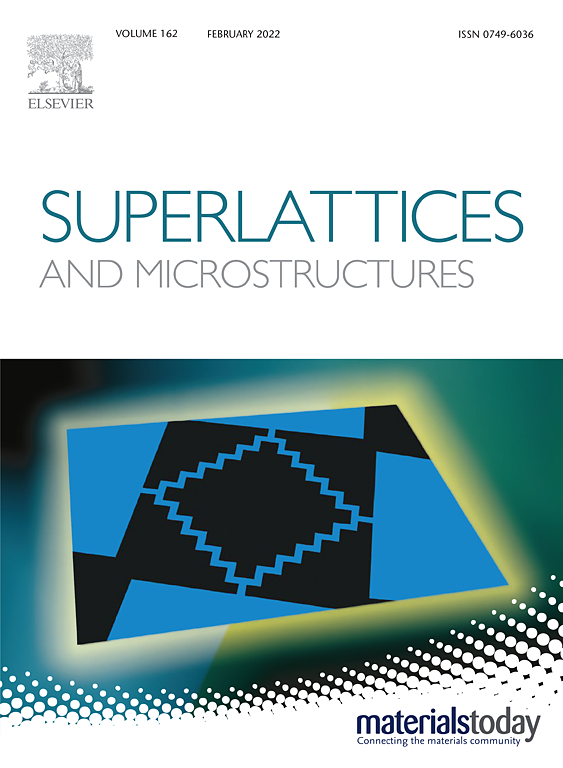Grain engineering of high energy density BaTiO3 thick films integrated on Si
IF 3.3
3区 物理与天体物理
Q2 PHYSICS, CONDENSED MATTER
引用次数: 0
Abstract
Ferroelectric (FE) ceramics with a large relative dielectric permittivity and a high dielectric strength have the potential to store or supply electricity of very high energy and power densities, which is desirable in many modern electronic and electrical systems. For a given FE material, such as the commonly-used BaTiO3, a close interplay between defect chemistry, misfit strain, and grain characteristics must be carefully manipulated for engineering its film capacitors. In this work, the effects of grain orientation and morphology on the energy storage properties of BaTiO3 thick films were systematically investigated. These films were all deposited on Si at 500 °C in an oxygen-rich atmosphere, and their thicknesses varied between ~500 nm and ~2.6 μm. While a columnar nanograined BaTiO3 film with a (001) texture showed a higher recyclable energy density Wrec (81.0 J/cm3vs. 57.1 J/cm3 @3.2 MV/cm, ~40% increase) than that of a randomly-oriented BaTiO3 film of about the same thickness (~500 nm), the latter showed an improved energy density at a reduced electric field with an increasing film thickness. Specifically, for the 1.3 μm and 2.6 μm thick polycrystalline films, their energy storage densities Wrec reached 46.6 J/cm3 and 48.8 J/cm3 at an applied electric field of 2.31 MV/cm (300 V on 1.3 μm film) and 1.77 MV/cm (460 V on 2.6 μm film), respectively. This ramp-up in energy density can be attributed to increased polarizability with a growing grain size in thicker polycrystalline films and is desirable in high pulse power applications.Si上高能量密度BaTiO3厚膜的颗粒工程
铁电(FE)陶瓷具有较大的相对介电常数和高介电强度,具有存储或提供非常高的能量和功率密度的电力的潜力,这在许多现代电子和电气系统中是理想的。对于给定的FE材料,例如常用的BaTiO3,必须仔细处理缺陷化学,失配应变和晶粒特性之间的密切相互作用,以设计其薄膜电容器。本文系统地研究了晶粒取向和形貌对BaTiO3厚膜储能性能的影响。这些薄膜均在500℃富氧气氛下沉积在Si表面,厚度在~500 nm ~ ~2.6 μm之间。而具有(001)织构的柱状纳米BaTiO3薄膜具有较高的可回收能量密度(81.0 J/cm3vs)。57.1 J/cm3 @3.2 MV/cm,比相同厚度(~500 nm)的随机取向BaTiO3薄膜的能量密度提高了约40%,随着薄膜厚度的增加,后者在电场减小的情况下表现出更高的能量密度。其中,1.3 μm和2.6 μm厚的多晶薄膜在2.31 MV/cm(在1.3 μm薄膜上施加300 V)和1.77 MV/cm(在2.6 μm薄膜上施加460 V)的外加电场下,储能密度分别达到46.6 J/cm3和48.8 J/cm3。这种能量密度的增加可以归因于在较厚的多晶薄膜中随着晶粒尺寸的增长而增加的极化率,并且在高脉冲功率应用中是理想的。
本文章由计算机程序翻译,如有差异,请以英文原文为准。
求助全文
约1分钟内获得全文
求助全文
来源期刊

Superlattices and Microstructures
物理-物理:凝聚态物理
CiteScore
6.10
自引率
3.20%
发文量
35
审稿时长
2.8 months
期刊介绍:
Superlattices and Microstructures has continued as Micro and Nanostructures. Micro and Nanostructures is a journal disseminating the science and technology of micro-structures and nano-structures in materials and their devices, including individual and collective use of semiconductors, metals and insulators for the exploitation of their unique properties. The journal hosts papers dealing with fundamental and applied experimental research as well as theoretical studies. Fields of interest, including emerging ones, cover:
• Novel micro and nanostructures
• Nanomaterials (nanowires, nanodots, 2D materials ) and devices
• Synthetic heterostructures
• Plasmonics
• Micro and nano-defects in materials (semiconductor, metal and insulators)
• Surfaces and interfaces of thin films
In addition to Research Papers, the journal aims at publishing Topical Reviews providing insights into rapidly evolving or more mature fields. Written by leading researchers in their respective fields, those articles are commissioned by the Editorial Board.
Formerly known as Superlattices and Microstructures, with a 2021 IF of 3.22 and 2021 CiteScore of 5.4
 求助内容:
求助内容: 应助结果提醒方式:
应助结果提醒方式:


